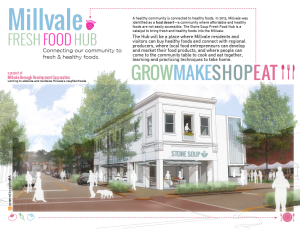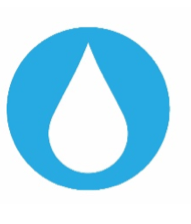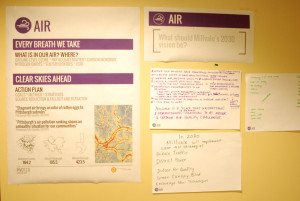The Millvale Ecodistrict Pivots
We’re proud to feature a guest post by Zaheen Hussain, reflecting on the Millvale Ecodistrict planning and implementation and what lies ahead
(above) photo of millvale by markpanza.com
In 2012, with the development of the Millvale Ecodistrict Pivot Plan, the community had selected three key issue areas to tackle—Food, Water, and Energy.
Without knowing the community, one might wonder why these three topics were what community members thought of first when evolveEA first started to help walk the community through its sustainable planning process. To those who live here, it couldn’t be more obvious. Millvale is a food desert, has a history of stream flooding, and has a strong sense of self determination through energy independence.
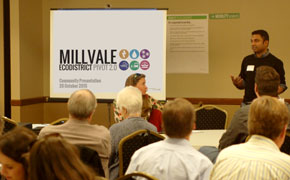
Zaheen welcomes the community at Millvale’s Pivot 2.0 ecodistrict planning session
Three years into our Millvale Ecodistrict journey, you’ll find that the community has been hard at work collaborating both internally as well with regional partners to start chipping away at the community’s goals. With over 70% of goals from the first iteration of the plan already complete, the community is turning its attention to the future by kicking off Millvale Ecodistrict Pivot 2.0 planning activities. Expanding its focus to Air, Mobility, and Equity, on October 26th, over 80 residents and community stakeholders came together to Imagine Millvale. Below, you can read more about what has been accomplished thus far and get a taste of what is yet to come between now and the year 2030.
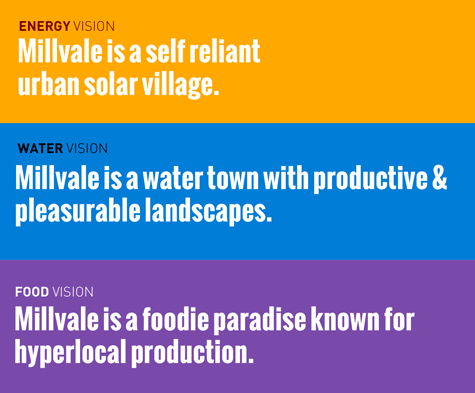
Community vision statements on Energy, Water and Food from the first Pivot Millvale Ecodistrict plan
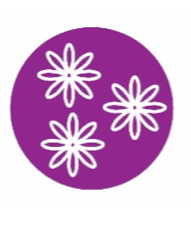
Food
Speaking of taste, Millvale has a goal of becoming a foodie paradise known for hyperlocal production. The Millvale Borough Development Corporation, and a number of partnering organizations have been hard at work to make this goal become a reality.
Known as the Town Square Project, the MBDC is redeveloping a once abandoned building into a fresh food hub. evolveEA worked with the MBDC develop the master plan for this building, as what was once an eyesore will now anchor itself as the town square. The two-story structure will feature a retail space, which for the first time in years will make fresh and healthy food consistently available to community members. Partnering with Farm Truck Foods, this will be a huge step forward in helping to reverse Millvale’s food desert status.
On the second floor, New Sun Rising (NSR), a local non-profit partner will be housing its Launch Millvale program which provides start-up incubation services for emerging food entrepreneurs. Program participants are helped through a 12 month program, after which they will walk away with a fully developed business plan. The partnership with NSR and the businesses that will hopefully emerge from this program fit well into the community’s desire to help add to its small business base. Located minutes from Downtown Pittsburgh, and across the river from Lawrenceville, Millvale is in a geographic sweet-spot for a burgeoning restaurant cluster.
In the meantime, the Gardens of Millvale, a project of the MBDC has been hard at work to help transform Millvale into a leader in urban farming. Currently a member of NSR’s Launch Millvale program, the Gardens of Millvale will not only continue to grow food in their existing, orchard, hoop house, and 8 lot community garden, but also hopes to be able to provide up to 95% of the food needs of the restaurant cluster in Millvale.
Water
Millvale has also been working to transform itself into a water town with water integrated into productive and pleasurable landscapes. The rain gardens at the Library, and a Borough parking lot as well as bioswales located near the historic Mt. Alvernia School are examples of green infrastructure that residents with yards as well as businesses can implement to help reduce the impact of stormwater runoff. As studies identify key low-cost high-return locations for further green infrastructure investments, residents can look forward to seeing even more gardens as well as rain barrels throughout town.
Millvale has also been partnering with a number of neighboring municipalities, and the Allegheny River Towns Enterprise Zone (ARTEZ), to implement a project that will connect residents to the beautiful Riverfront Park, which is a huge environmental and economic asset, but is difficult to access due to the on and off ramps of the busy Route 28 being located at the entrance to the park.
Energy
With the goal of becoming a self reliant urban solar village, Millvale has been hard at work becoming more energy independent.
Solar and other renewable forms of energy are at the heart of these goals, but with a lot of wisdom, the community decided to start by addressing energy efficiency and building performance first.
A participant in ReEnergize Pgh’s Energy Efficiency Challenge, Millvale as a community won a three community energy efficiency competition in which participating households came together and used more than 8% less energy than they did last year. Residents not only changed their behavior, but also learned about how they can make improvements to their homes to help it perform better.
Meanwhile, the Library, which is already energy efficient, has expanded its solar installation and is now generating more electricity than it uses. This has allowed the library the financial capacity to remain open longer and offer more community programming. The Library was also able to lead efforts to fully solarize the Imagine building located next door and partially solarize the Millvale Community Center.
Thinking of the library as the epicenter, Millvale hopes that one day, all the south facing roof-tops will have solar arrays powering the community with clean and renewable energy. While we wait for that to come to fruition, residents should be on the lookout for for information on the newly formed Allegheny Solar Cooperative, which aims to democratize community solar ownership through member owned solar installation on the rooftops of community organizations.
Air, Mobility, and Equity
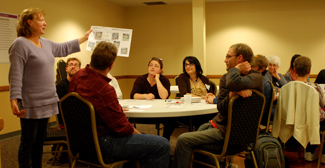
Community members at the Pivot 2.0 Millvale Ecodistrict meeting, October 2015
These are of course the three newest issue areas identified through the new round of planning. In some ways, the community has already been implementing projects that touch on these topics. Sometimes they were a part of the preexisting food, water, and energy goals. Other times, they were one-off stand-alone projects. As early projects come to a close, formally including these three topics into the Millvale Ecodistrict Plan will allow for more intentional and systematic programming with greater depth and long term goal setting.
One such effort has been led by the MBDC and the Millvale Borough Bike & Pedestrian Committee. With support from the Heinz Endowments Youth Philanthropy Program, Millvale will soon have sharrows and street signs guiding bikers through the heart of town and letting drivers to know be more mindful of non-motorized traffic. As complete streets thinking gains popularity in cities all across the world, Millvale can start to become a pioneer by improving road, side-walk, and cross-walk safety, and increasing Mobility.
This, and many of the Energy initiatives also have impact on our Air. Many already know that Allegheny County has some of the worst air quality in the nation. By incorporating Air into our community plan, it gives us a platform to develop more educational programming as well as a formalized way to analyze how the community can reduce the negative impacts of air coming in from elsewhere while we improve our own emissions.
Equity, which in sustainability terms addresses fairness, is an exciting addition to our community planning efforts because one can make the case that everything we have discussed thus far in one way or another addresses equity within the community. For example, having access to food, being able to breathe clean air, feeling safe traveling, not living in fear of flooding, and being able to afford clean energy are all matters of fairness, and often walks the line of human rights. Additionally, this allows us to incorporate sustainable housing affordability, health, and education into the fold. As Millvale starts the journey towards regaining the economic stability it once enjoyed, including equity as part of the conversation helps to ensure that the change that comes into the community is by, and for Millvale residents first.
All of the initiatives described are a part of Millvale’s greater goal of becoming a more sustainable and resilient community accessible for all—something it has been working to become for the greater part of the past decade.


